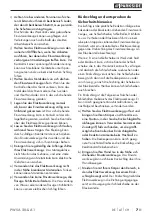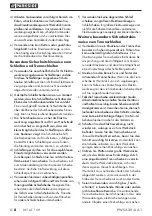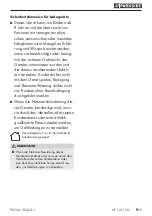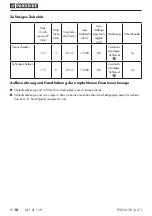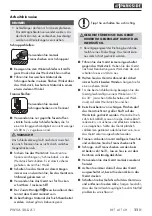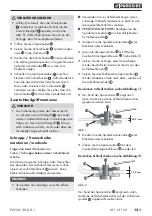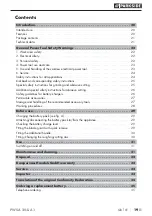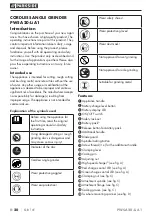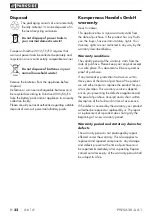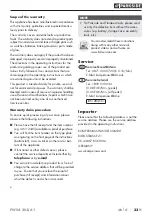
PWSA 20-Li A1
GB
│
IE
│
21
■
Package contents
1 cordless angle grinder PWSA 20-Li A1
1 additional handle
1 blade guard (pre-assembled)
1 two-hole mounting spanner
1 cutting disc (pre-assembled)
1 operating manual
Technical data
Cordless angle grinder: PWSA 20-Li A1
Rated voltage:
20 V
(DC)
Rated speed:
n 10000 rpm
Disc width:
Ø 115 mm
Thread size:
M14
Use the following battery to operate the
cordless tool: PAP 20 A2*
Type:
LITHIUM
ION
Rated voltage:
20 V
(DC)
Capacity:
3
Ah
Cells: 10
To fast-charge the battery pack, use the
following high-speed battery charger:
PLG 20 A2*
INPUT:
Rated voltage:
230–240 V ~, 50 Hz
(AC)
Rated power
consumption:
85
W
Fuse (internal):
3.15 A
T3.15A
OUTPUT:
Rated voltage:
21.5 V
(DC)
Rated current:
3.5 A
Charging time:
approx. 60 min
Protection class:
II / (double insulation)
* BATTERY AND CHARGER ARE NOT SUPPLIED
NOTES ON COMPATIBILITY
►
Alternatively, you can use the high-speed
battery charger PLG 20 A1/PLG 20 A2 to
charge the battery pack PAP 20 A1/PAP 20 A2.
►
You can also use the battery pack PAP 20 A1
to operate the cordless electric tool.
Noise and vibration data:
Noise measurement value determined in accord-
ance with EN 60745. The A-rated noise level of
the power tool is typically as follows:
Noise emission value:
Sound pressure level: L
PA
=
89 dB(A)
Uncertainty: K
=
3
dB
Sound power level:
L
WA
= 100 dB(A)
Uncertainty: K
=
3
dB
Wear hearing protection!
Total vibration value:
Surface sanding
main handle:
a
h, AG
= 5.3 m/s
2
Uncertainty:
K = 1.5 m/s
2
Surface sanding
additional handle:
a
h, AG
= 7.7 m/s
2
Uncertainty:
K = 1.5 m/s
2
NOTE
►
The vibration level specified in these instruc-
tions has been measured in accordance with
a standardised measuring procedure and
can be used for equipment comparisons. The
specified vibration emission value can also
be used to make an initial exposure estimate.
WARNING!
►
The vibration level varies depending on the
use of the power tool and may be higher
than the value specified in these instructions
in some cases. Regular use of the power tool
in this way may cause the user to underesti-
mate the vibration. Try to keep the vibration
loads as low as possible. Measures to reduce
the vibration load are, e.g. wearing gloves
and limiting the working time. Wherein all
states of operation must be included (e.g.
times when the power tool is switched off and
times where the power tool is switched on but
running without load).

